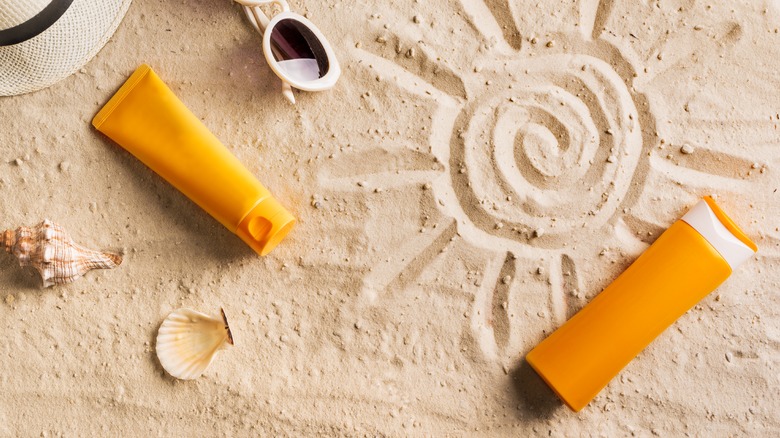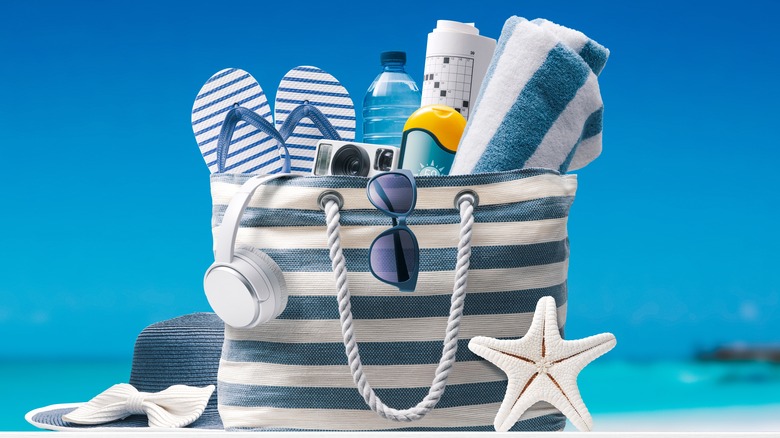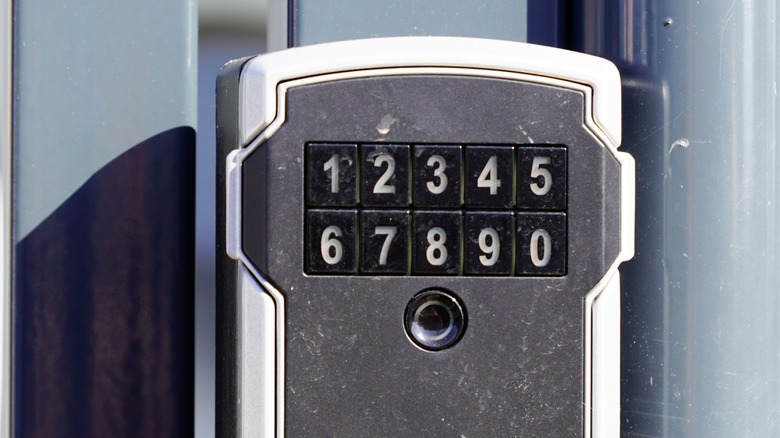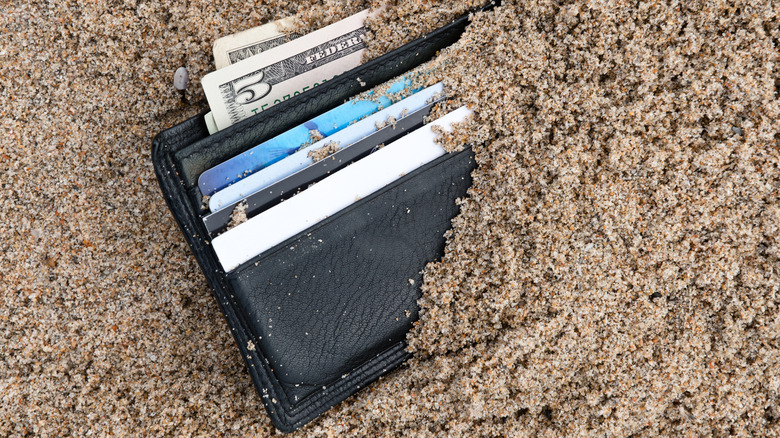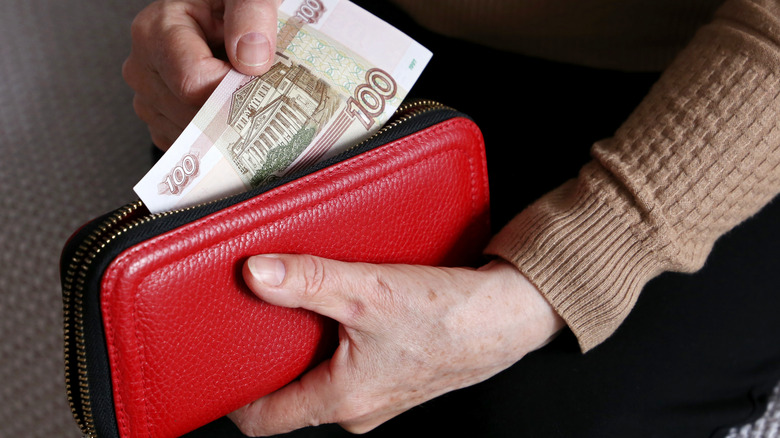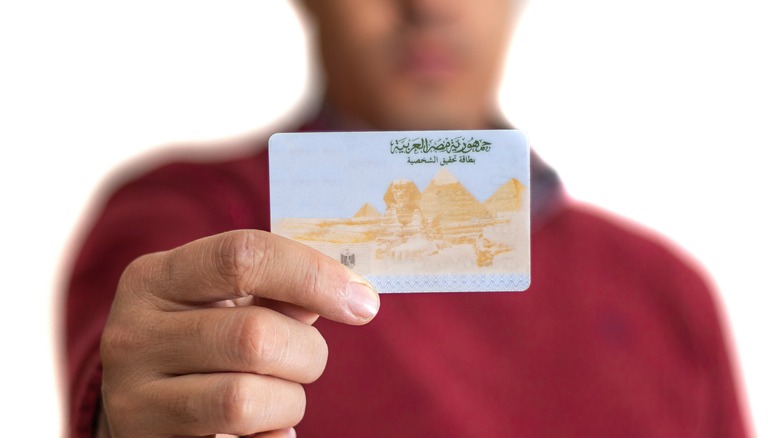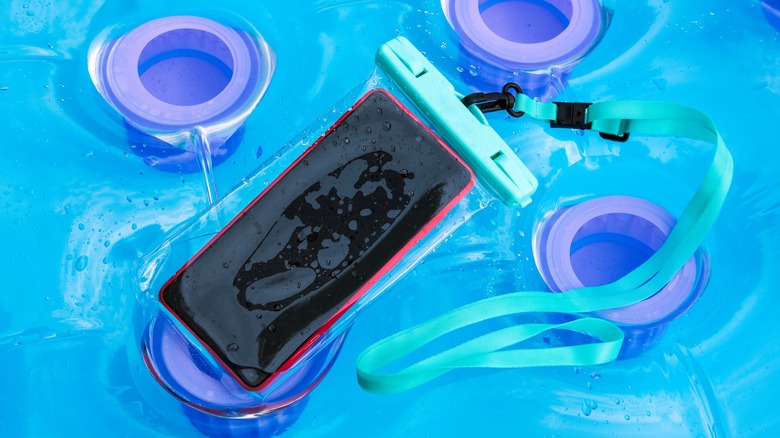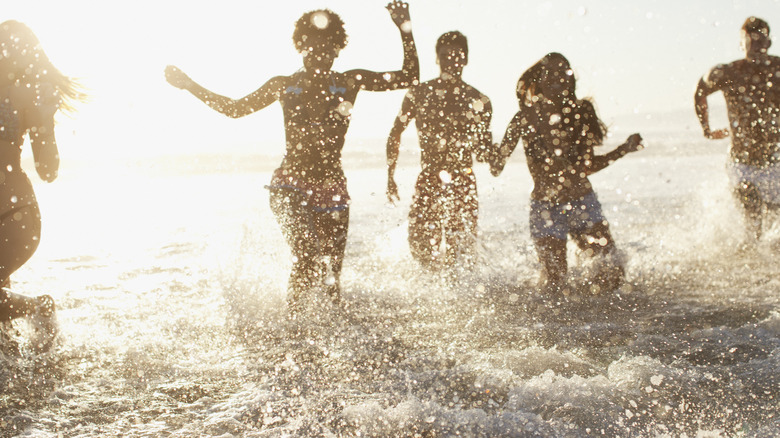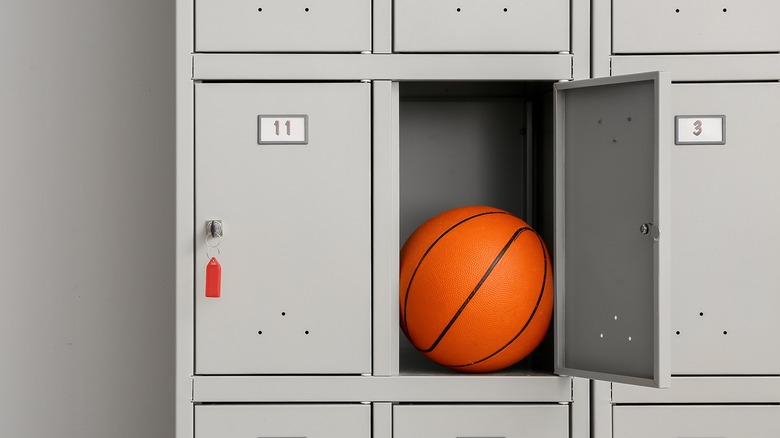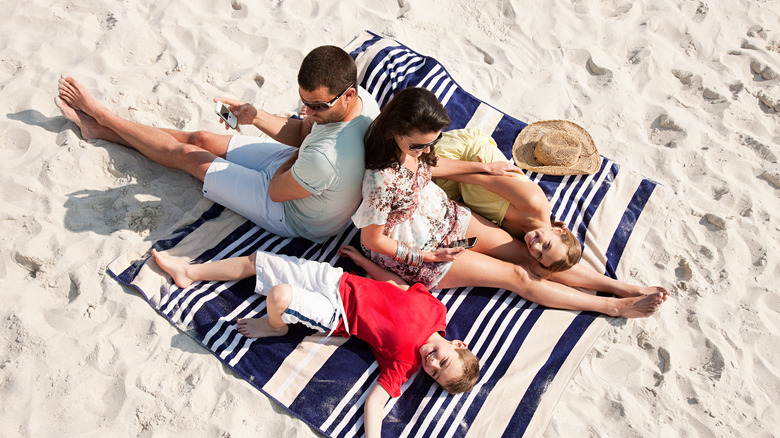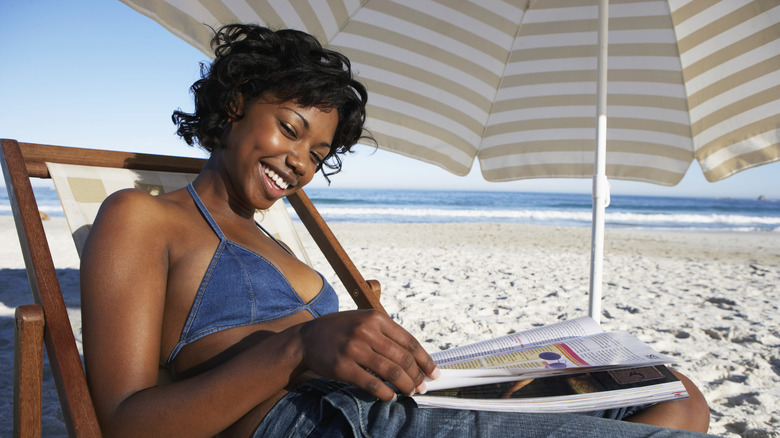Tips For Keeping Your Valuables Safe At The Beach
Going to the beach should be a relaxing, exhilarating time. But beachgoers often worry about they pack along for the trip. Whether the concerns are avoiding theft or preventing water damage on electronic items, there's a lot to consider when packing a beach bag. The busy tourist season is also the busiest time for beach thieves. So, if you plan on visiting a beach during those crowded days, it's even more important to keep these safety tips in mind.
One less talked-about way to keep your belongings safe is to pack a nondescript beach bag. Try not to bring one that's brightly colored with the name of your hometown or a well-known beach town like Miami on it if that's not where you are. You want to blend in with the other beachgoers, not stand out. Consider bringing a bag without words, or even turning yours inside out if it has emblazoned words on it. It's a bit like wearing a patriotic shirt in another country: Everyone immediately knows you're not from there.
Thefts that happen at beaches are also commonly known as beach blanket thefts, and tend to be most prominent at famous, touristy beaches like those in Rio de Janeiro, per Corporate Travel Safety. It's difficult to chase down beach thieves who swipe your belongings, especially if you're in the water with your items unattended. There is no guarantee that taking these steps will keep your belongings safe, though precautions are far more likely to help than hurt.
Use secret hiding containers
Lots of companies sell decoy objects that can double as safes. Fake hairbrushes with a secret compartment in the handle, soda cans, and sunscreen bottles are all great places to hide your valuables. If you don't want to invest in a decoy, you could always clean out an old sunscreen container and create your own with a little ingenuity. The same can be done with an empty chapstick or lipstick tube to stash some cash away. Any empty container that seems beach-appropriate could be fashioned into a recycled item vault.
Even if you're using decoy containers, be smart with them. They can still be buried under towels or sand, or left in your beach bag (via Vagrants of the World). When using the stash safes, it's best to operate under the assumption that a thief will know it's a decoy. Assume every item is a target for thieves, especially as they become more common at beaches or in public spaces. Also, make sure your containers are opaque even if held against the light, to stop anyone from knowing at a glance that it isn't a real bottle of sunscreen or a hairbrush.
Bring a lockable bag
Several bag manufacturers sell beach bags that lock or act as a beach safe. While that won't stop a thief from taking the whole bag, it will make it harder for them to get into your belongings to rummage around. It is certainly less conspicuous if a thief makes off with an entire bag if they want to stop at multiple beach spots. Many of the bags are made with beach safety in mind and are even waterproof, which can help prevent your items from belong damaged.
These kinds of bags also make for excellent personal items for the plane ride. Any items that can pull double duty on a trip are ideal to pack, since they're multipurpose. Just be sure you don't lock them ahead of airport security, because non-compliant bag locks are not allowed through airport securitym particularly with the TSA.
Bags such as the CoolBag act as part secure storage and part cooler. It has puncture proof zippers and material, along with RFID blocking and multiple pockets for storage (via JTG Travel). Having a well made, multi-functional locking bag is a great addition to your list of personal travel items. Beaches aren't the only places where bags are easily broken into, so a lockable bag is an excellent investment all around.
Get a portable chair locker
There are portable lockers and lockboxes with built-in cables to keep them attached to your beach umbrella or chair while you're away. These handy devices are a great way to keep your possessions safe and sound while you are floating nearby. These cables are often steel and cut-proof, too. The Master Lock Portable Safe, for example, is not only waterproof, but also comes with a cable to keep it tethered to your chair or umbrella. Being able to tie the locker or safe down is one way to keep thieves from just snatching it to pry open later.
Meanwhile, the more portable AquaVault is much easier to pack with its size and design. Because it's made of fabric, the vault can more easily fit into luggage or even your beach bag to keep your most valuable items safe. The design is such that the vault attaches to the back of a beach chair, which keeps it secure while also being more out of sight than other portable lockboxes. Plus, there are a lot of storage options in the back, including side pockets for easy access to things like water bottles or sunscreen.
Bury valuables
When burying your belongings at the beach, there are two ways to go about it: the old-school way and the new school. For the old-school route, consider using a dry bag or another waterproof bag, putting your items inside, and digging a small hole. Place your items inside the hole and cover them with your beach towel. Now no one is any the wiser that you've stashed your things; just don't forget about the hole and accidentally step on it, or you may end up with a broken ankle. One way to remember the location of your hiding hole is to keep your beach bag near it or on top of it as an additional security measure.
If you want to take a more advanced approach to the technique, you could invest in something like the Beach Vault. This item screws into the sand, giving you space to tuck away a few valuable items before keeping them in the vault (via Business Insider). Plus, the vault comes with a beach towel and pillow to obscure its location in the sand. At least, this method of burying your items doesn't leave a big empty hole to fall into. There isn't a lid for the Beach Vault, but it does have a silicone ring around the top to help prevent water from seeping into the vault itself.
Limit what you bring
You can take steps to keep your things at the beach safe, but you should also consider what you actually need for the day. The best way to keep your valuables safe is to leave them behind in a more secure place. Only bring what you need for the day, don't overpack, and try to leave anything you don't need behind. As nice as it is to have a tablet to read from rather than a heavy book, it's easy to damage electronics at the beach or have them stolen.
Also, consider not bringing all of your cash and cards with you. This is a security risk, whether you're going to the beach or not. Try to bring just one card, a mix of one card and a little bit of cash, or just the cash you think you'll need for the day. By leaving everything else behind, you can avoid having more at risk of theft. Plus, a lot of the beach vault options are small, so you need to consider what will fit in them before hauling a lot of stuff with you.
Lastly, try not to bring your passport to the beach. Losing it is a terrible thing to happen at the beach, but getting it wet can be just as bad. Water can damage your passport so badly that it can't be used at all, requiring you to get a new one.
Keep cards/IDs with you
One of the best ways to keep things like your photo ID, cash, and bank cards safe is to keep them with you at all times — yes, even in the water. Gadgets like the wrist locker are an easy way to keep your important items on hand (literally), wherever you are. Although wrist lockers aren't waterproof, they are snug and unlikely to fall off, even in rough water. Additionally, many of them are built for long-term use.
According to Wallet Hub, credit cards are fairly waterproof. They are designed for durability; if water somehow gets inside a card, it should retain its normal electronic function once it dries. That said, it makes even more sense to keep something like a credit card or ID with you while you're swimming.
Waterproof pouches are another smart way to keep everything with you. They can be worn around your neck or waist, or however you choose to wear them. Corporate Travel Safety suggests keeping your money, keys, and anything else you can fit in there to maintain peace of mind oceanside. It's also advisable to use waist pouches over neck pouches, since neck pouches are more likely to float off from the waves coming at you.
Bring a waterproof bag for tech
Protecting tech from water damage has come a long way from makeshift ziplock baggies. Waterproof phone pouches on lanyards are excellent travel companions, especially on beach days (per Escape! Monthly). They lock in place, you can still use your phone while it's in the pouch, and the lanyard makes using your phone and not dropping it much easier. Plus, phones are pretty water-resistant nowadays, so even if a little water somehow gets into the pouch, your device should be okay. Just be sure to air the pouch out in between uses, so mold doesn't grow inside it.
Pouches are usually made of thick layers of plastic to seal out any water, which can make them difficult to open. It's also worth noting that sometimes, photos taken inside the pouch may turn out blurry or fuzzy due to droplets on the pouch itself. Still, a fuzzy image is better than a waterlogged phone.
In a pinch (or to save some money), zip-close (e.g., Ziploc) bags are still an effective solution for keeping tech safe at the beach. You may also opt to store your gadget in a zip-close bag and keep that inside a waterproof pouch, for extra protection. After all, you can never be too careful when it comes to electronics.
Take turns watching your stuff
Sometimes, a beach day means a group heading to the sand. If that's the case for your beach day, consider taking turns with your companions watching your group's belongings. You can take turns going to the water or watching the stuff and make it fair for everyone.
There's typically one beach bum in a group who just wants to spend time in the sand reading a good book. If your group happens to have one, be sure to thank them if they offer to guard your things the whole time.
If you're headed to the beach by yourself, asking a stranger to watch your things for you might be an okay option. Vagrants of the World suggests being wary of this choice, but also offers a few suggestions on how to do it safely. Look for families or older couples to talk to, instead of teens, young adults, or folks who are drinking. In other words, use your best judgement if you plan to rely on the kindness of strangers.
Look for lockers
While not common, some beaches have lockers you can rent to keep your valuables in when you aren't using them. They may cost a fair bit of money to rent; however, knowing your things are locked away safely is probably worth the additional expense. If the beach has a locker area, you could find a place on the sand nearby to camp out at for the day. That way, you don't have to trek very far to retrieve your things, or you can go back as you need to retrieve items throughout the day as well.
Adventurous Kate says these kinds of lockers are more common in Europe, and frequently come complimentary if you rent chairs and umbrellas at the beach. Furthermore, she suggests going kayaking or paddleboarding, because the companies that offer such activities usually provide means to store your belongings safely while you're out enjoying water sports.
Keep your stuff in sight
Even if you can't be physically by your belongings at all times, you can pick a place to swim that's within sight of your beach spot. Don't wander too far from where your things are when you go to the water, and be sure to still have an eye on where you've parked on the sand. This is easy to do if you remember some markers near your spot, like a certain colored umbrella or a landmark on the beach.
While it's important to keep an eye on your belongings as a group, it's equally vital to make sure your most valuable items aren't in sight at all. Hide your phone, tablet, cash, or any other items you want protected while you're away from your spot. If you can see something on your towel or in your bag from a quick glance, so can a thief. So as a rule of thumb: keep your towel, chair or umbrella in sight, but your belongings out of sight.
Bring decoy items
For certain items you really want to bring to the beach, consider bringing something else to help disguise it. An e-reader, for example, could easily be hidden while reading inside a physical book or magazine. This way, while you're reading it or when it's sitting out, it doesn't appear as an expensive piece of tech. Just be sure you keep them together when you put them back in your bag, lest you break the illusion. Don't leave the tablet inside your book, though, as it will damage the spine.
Some travelers pack decoy wallets to fool thieves, keeping their money somewhere else instead. That might be a good option if you are going to keep your money on you while you're at the beach. Consider packing an old wallet as a decoy, so that a would-be thief would end up taking it (and subsequently decide that you aren't a worthwhile target).
Choose a spot near other people
When choosing your spot on the beach, consider one near other people or the lifeguard. If you do that, there will be a few extra eyes to keep an eye on what's happening in your area — particularly lifeguards, who will likely notice if any thieves are afoot (per Nomad Paradise). It may sound counterintuitive because you want to keep your valuables out of sight from other people, but for the safety of your belongings and yourself, it's better to be around other people.
This is an especially helpful tip for solo or duo travelers. When choosing a place to sit, survey what groups of people are up to. Sitting near families will create an entirely different environment for you, compared to sitting near the day drinkers playing volleyball. Whether people mean to or not, they tend to watch what other folks are doing. So even if you don't explicitly ask anyone to watch your things, there's a good chance that people nearby will see if something is going on.

